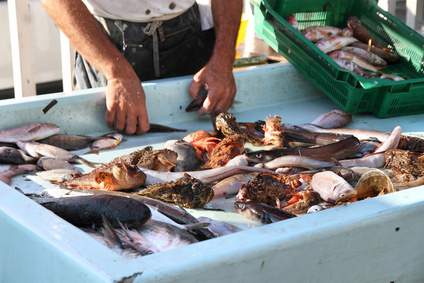How fresh is your fish?
The question as to whether a fish is fresh can be more easily judged by human senses than by technical devices.

Does the skin shine like pearls? Do the eyes have a dark metallic sheen? Does the skin have a light cucumber-like smell? Salmon with these characteristics can be served with confidence - the fish is fresh.
Fish is a very sensitive food that can only be kept fresh on ice for 8 to 14 days depending on the species. On the way from the boat to the customer the quality of this easily perishable product must therefore be continually checked.
This task is more easily achieved by human observation than through the use of instruments to perform physiochemical analysis. In the everyday practice of the fish industry therefore, trained fish inspectors judge smell and visual appearance using the most standardized criteria possible. For this task they now have the support of a new tool: a systematic guideline called the Quality Index Method, or QIM.
With the QIM-questionnaire various characteristics are evaluated, and the skin, eyes, gills, and stomach of the fish are judged separately. The questionnaire is multiple choice and is scored using a demerit system of 0 to 3. The higher the score the shorter the time the fish can still be kept fresh enough to sell. The length of the shelf life can be deduced from the QIM evaluation tables.
The data can also be fed into a small computer and a special QIM-software programme will complete the analysis and give the appropriate results. Thus the seller can give the results immediately to the customer. This is advantageous in a time when fish auctions take place over the internet and the catch is sold online before the boat has reached the harbour.
Fish is not just fish
The current EU-guidelines give only general parameters in judging the freshness of all types of fish. QIM will make the evaluation of the freshness of fish not only faster but also more precise, since the method gives more exact sensory criteria for the various species. For instance the colour of the gills of a fresh fish differs from one species to the other; it might be described as dark red in one and pinkish in another. The same is the case for smell. Whereas species with high levels of fat have a smell described as oily, fish with a low fat content have a smell described as metallic or sea-weedy. Additionally, some sorts of fish spoil more easily than others. For instance, the shelf life of herring is approximately 8 days, while salmon can be kept on ice for some 20 days.
In a new EU-project it is planned to introduce the QIM-system for European quality control in the near future. All institutions involved agree that this method will help to assure food safety and will offer a trustworthy measurement for quality comparison. The method gives important feedback to the fish industry allowing it to optimise the quality of production. A simplified version of the Quality Index Method for consumers is in the planning. This will allow the retail shopper to better judge the freshness of the product.
Source:
Emilia Martinsdottir
IFL Icelandic Fisheries Laboratories, Reykjavík
Iceland
Photo: © ballylocci - Fotolia.com